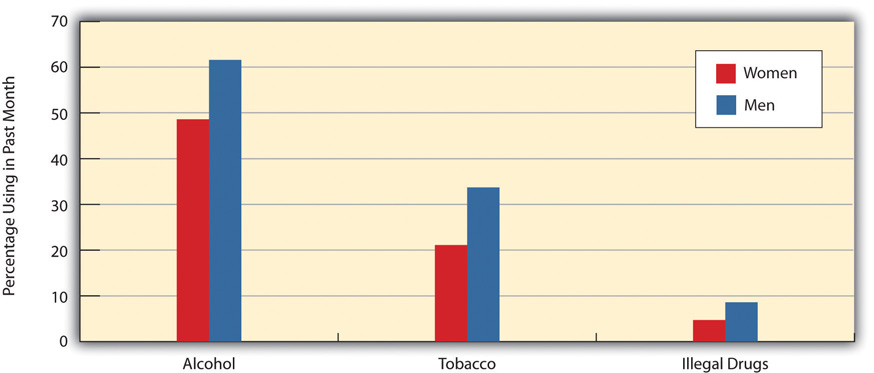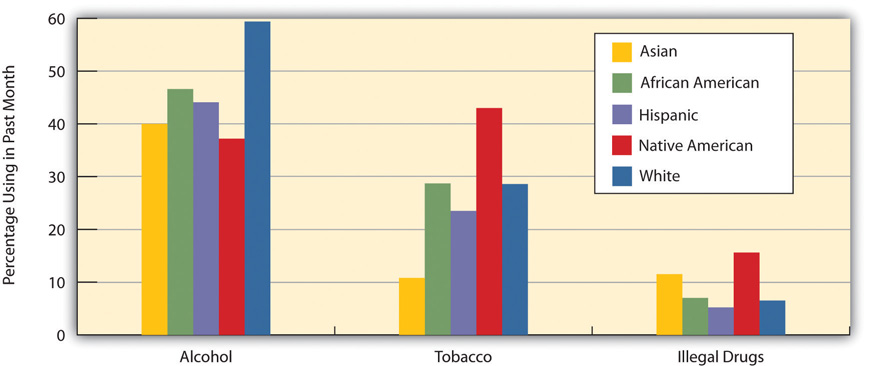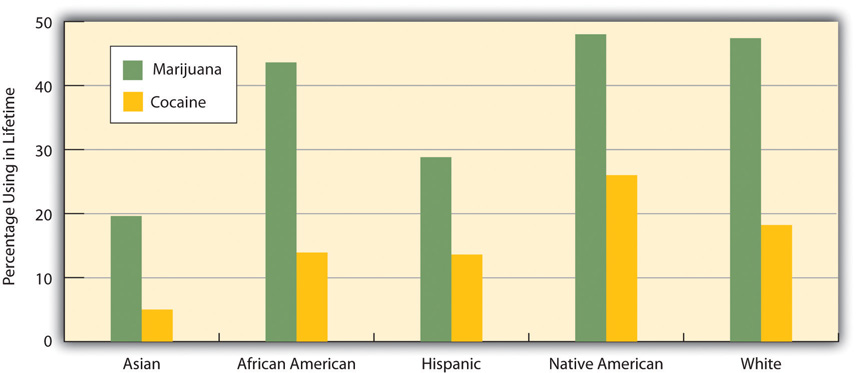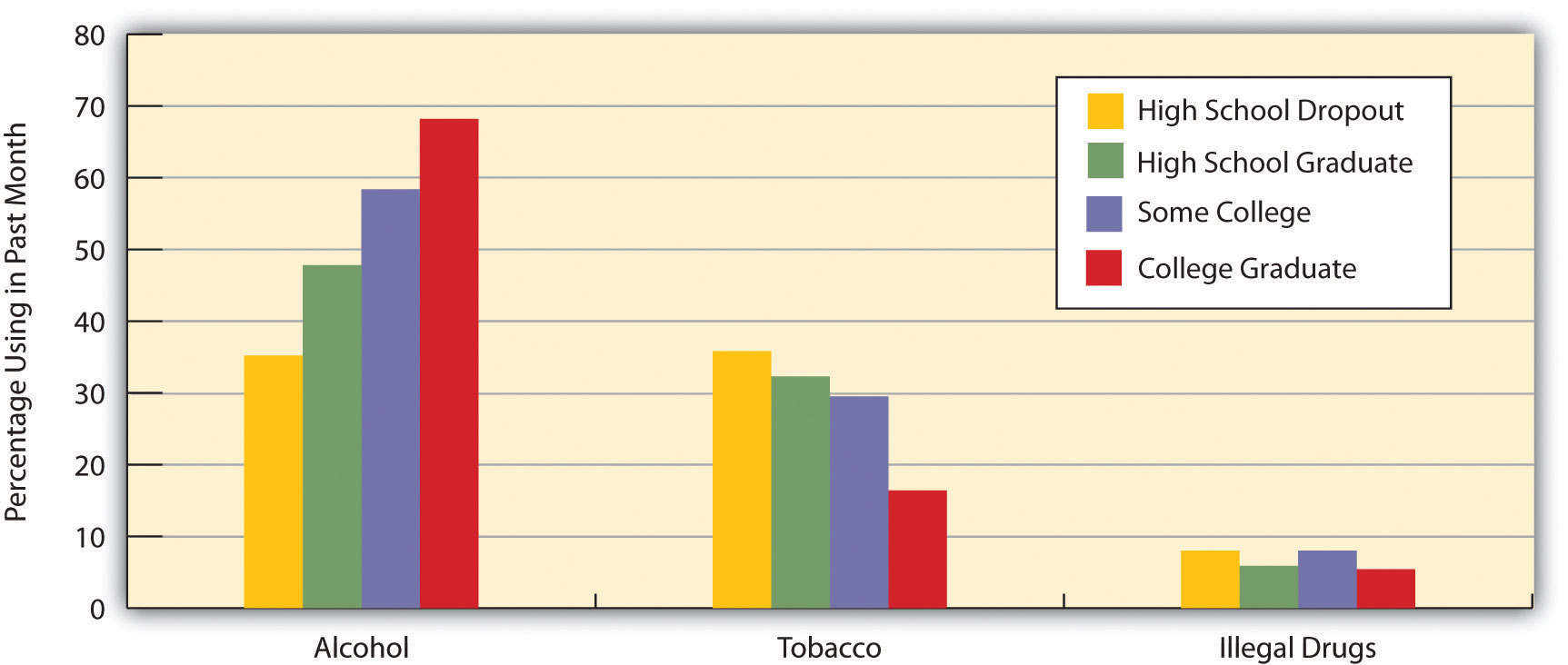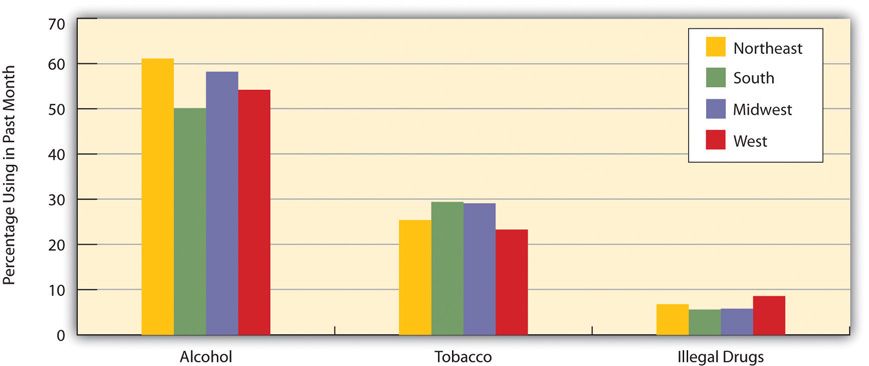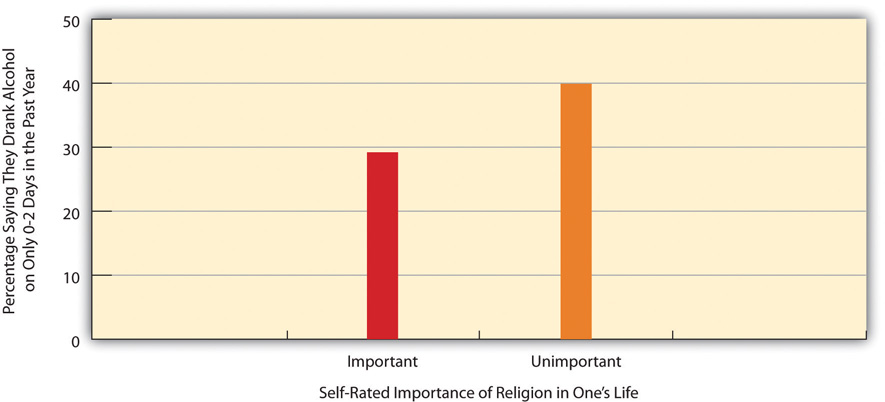7.3 Social Patterning of Drug Use
Learning Objectives
- Outline the nature of gender differences in drug use.
- Understand whether racial and ethnic differences in drug use exist.
- Explain whether education and religiosity are related to drug use.
It is a sociological truism that our sociodemographic backgrounds—gender, race and ethnicity, social class, and so forth—influence many of our behaviors and attitudes. Drug use is no different. By examining the social patterning of drug use, we can see which kinds of people, in terms of their sociodemographic backgrounds, are more or less at risk for using drugs. And by understanding these sociodemographic differences, we begin to understand why some people are more likely than others to use drugs. Our examination of these differences will rely heavily on data from the SAMHSA survey discussed earlier and focus on past-month differences in alcohol, tobacco, and illegal drug use (all illegal drugs combined).
Gender
In the study of crime and deviance, gender is an important predictor: Males are more likely than females to commit the more serious forms of crime and deviance, such as homicide, robbery, and burglary. This pattern generally holds true for drug use of various types. Figure 7.2 “Gender and Prevalence of Alcohol, Tobacco, and Illegal Drug Use, Ages 26 and Older, 2010 (Percentage Using in Past Month)” shows that men are more likely than women to use alcohol, tobacco, and illegal drugs. In related data, men are also more than twice as likely as women to engage in binge drinking (30.7 percent compared to 13.8 percent) and heavy drinking (9.7 percent compared to 2.8 percent) as defined earlier.
Figure 7.2 Gender and Prevalence of Alcohol, Tobacco, and Illegal Drug Use, Ages 26 and Older, 2010 (Percentage Using in Past Month)
Source: Substance Abuse and Mental Health Services Administration. (2011). Results from the 2010 national survey on drug use and health: Summary of national findings. Rockville, MD: Author.
Why do these gender differences exist? A common thread underlines gender differences in criminal behavior and in drug use of various kinds, and that is masculinity (Lindsey, 2011). Compared to girls, boys are raised to be more active, assertive, and daring, and to be less concerned about the effects of their behavior on others. As they grow older, these traits make them more likely to use drugs and also to commit various types of crimes. Ironically, the way that most parents raise their sons helps make their sons more likely than their daughters to drink, smoke, and use illegal drugs once they reach adolescence and in the many decades of their adulthood.
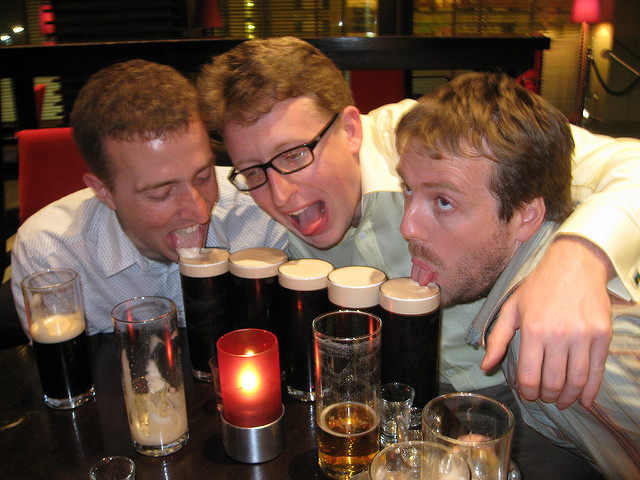
On the average, males drink alcohol more often and more heavily than females, and they are also more likely to use other types of drugs.
David, Bergin, Emmett, and Elliott – IMG_3110 – CC BY 2.0.
In an important exception to the general gender difference just discussed, females are more likely than males to use prescription drugs for nonmedical reasons (Ford, 2009). The reasons for this counterintuitive finding are unclear, but scholars speculate that because girls and women obtain more prescription drugs than do boys and men, their greater nonmedical use of prescription drugs reflects the fact that they have more access to these drugs in the first place.
Race and Ethnicity
Racial and ethnic differences in drug use of various types exist to some extent but are less clear-cut than the gender differences we just examined (see Figure 7.3 “Race/Ethnicity and Prevalence of Alcohol, Tobacco, and Illegal Drug Use, Ages 26 and Older, 2010 (Percentage Using in Past Month)”). For alcohol use, whites have the highest rate of drinking, and Native Americans, despite the popular image that they have alcohol problems, have the lowest rate. For tobacco use, Native Americans have the highest rate of use, and Asians have the lowest rate. For illegal drugs, Native Americans again have the highest rate of use, and Hispanics have the lowest rate. Note that African Americans have roughly the same illegal drug use rate as whites, and have lower rates of alcohol and tobacco use than whites do. Although many people believe that African Americans are more likely than whites to use drugs, research data show that this belief is a myth.
Figure 7.3 Race/Ethnicity and Prevalence of Alcohol, Tobacco, and Illegal Drug Use, Ages 26 and Older, 2010 (Percentage Using in Past Month)
Source: Substance Abuse and Mental Health Services Administration. (2011). Results from the 2010 national survey on drug use and health: Summary of national findings. Rockville, MD: Author.
The illegal drugs category includes many types of drugs. We do not have space to illustrate racial/ethnic differences in the use of each of these drugs, but we will examine differences in marijuana and cocaine (including crack) use. Figure 7.4 “Race/Ethnicity and Prevalence of Marijuana and Cocaine Use, Ages 26 and Older, 2010 (Percentage Using in Lifetime)” shows these differences for lifetime use. Despite some minor differences, African Americans, Native Americans, and whites have the highest lifetime use of marijuana, while Asians and Hispanics have the lowest use. Turning to cocaine, Native Americans have the highest lifetime use, and Asians have the lowest use. Note again that African Americans have a lower rate of lifetime use than whites; this racial difference will be relevant for our discussion toward the end of the chapter of the racial impact of the legal war on drugs since the 1970s.
Figure 7.4 Race/Ethnicity and Prevalence of Marijuana and Cocaine Use, Ages 26 and Older, 2010 (Percentage Using in Lifetime)
Source: Substance Abuse and Mental Health Services Administration. (2011). Results from the 2010 national survey on drug use and health: Summary of national findings. Rockville, MD: Author.
Education
Education differences in drug use depend on the type of drug (see Figure 7.5 “Education and Prevalence of Alcohol, Tobacco, and Illegal Drug Use, Ages 26 and Older, 2010 (Percentage Using in Past Month)”). For alcohol, higher levels of education are associated with a higher likelihood of drinking. One possible reason for this association is that people with lower levels of education are more likely to be religious, and people who are religious are less likely to drink. For tobacco, higher levels of education are associated with lower levels of tobacco use. In particular, college graduates are much less likely to use tobacco than people without a college degree. For illegal drugs, there is no clear association between education and use of these drugs, although college graduates report the lowest past-month use.
Figure 7.5 Education and Prevalence of Alcohol, Tobacco, and Illegal Drug Use, Ages 26 and Older, 2010 (Percentage Using in Past Month)
Source: Substance Abuse and Mental Health Services Administration. (2011). Results from the 2010 national survey on drug use and health: Summary of national findings. Rockville, MD: Author.
Region of Country
The regions of the United States differ in many attitudes and behaviors, and one of these behaviors is drug use (see Figure 7.6 “Region of Country and Prevalence of Alcohol, Tobacco, and Illegal Drug Use, Ages 26 and Older, 2010 (Percentage Using in Past Month)”). The regional differences are not large, but the South has lowest rate of alcohol use, in part reflecting the fact that it is the most religious region in the nation. The South and Midwest have the highest rates of tobacco use, while the West has the lowest rate, befitting its image as a “healthy” region. However, the West also has the highest rate of illegal drug use, although its use is only slightly higher than the other regions’ use.
Figure 7.6 Region of Country and Prevalence of Alcohol, Tobacco, and Illegal Drug Use, Ages 26 and Older, 2010 (Percentage Using in Past Month)
Source: Substance Abuse and Mental Health Services Administration. (2011). Results from the 2010 national survey on drug use and health: Summary of national findings. Rockville, MD: Author.
Religiosity
A growing number of studies finds that religiosity—how religious someone is—affects how often people use various drugs: The more religious people are, the lower their drug use; conversely, the less religious they are, the higher their drug use (Desmond, Soper, & Purpura, 2009). We can see evidence of this relationship in Figure 7.7 “Religiosity and Drinking among Youths Ages 17–18 (Percentage Saying They Drank Alcohol on Only 0–2 Days in the Past Year)”, which presents data for a nationwide sample of youths ages 17–18. Those who say religion is important in their lives report less drinking (i.e., on only 0–2 days in the past year) than those who say religion is unimportant in their lives.
Figure 7.7 Religiosity and Drinking among Youths Ages 17–18 (Percentage Saying They Drank Alcohol on Only 0–2 Days in the Past Year)
Source: National Longitudinal Study of Adolescent Health, Wave I. (2012). Retrieved from http://www.icpsr.umich.edu/cgi-bin/SDA/DSDR/hsda?dsdr+21600-0001.
Key Takeaways
- Drug use is socially patterned: Aspects of our sociodemographic backgrounds affect our likelihood of using various drugs.
- Perhaps the clearest social pattern involves gender, with males more likely than females to use and abuse alcohol, tobacco, and illegal drugs.
- Despite common beliefs, the rate of illegal drug use is lower for African Americans than for whites.
For Your Review
- The text discusses five social patterns of drug use: gender, race/ethnicity, education, region of country, and religiosity. Taking into account these five sets of patterns, write a short essay in which you use this information to understand your own level of use (or nonuse) of alcohol, tobacco, and illegal drugs.
- Did it surprise you to read that illegal drug use is lower among African Americans than among whites? Why or why not?
References
Desmond, S. A., Soper, S. E., & Purpura, D. J. (2009). Religiosity, moral beliefs, and delinquency: Does the effect of religiosity on delinquency depend on moral beliefs? Sociological Spectrum, 29, 51–71.
Ford, J. A. (2009). Nonmedical prescription drug use among adolescents: The influence of bonds to family and school. Youth & Society, 40(3), 336–352.
Lindsey, L. L. (2011). Gender roles: A sociological perspective (5th ed.). Upper Saddle River, NJ: Prentice Hall.

